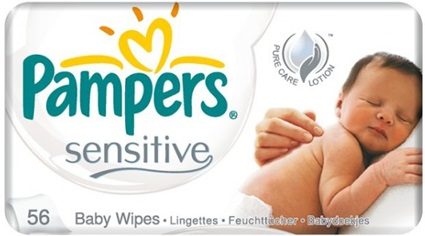Creating an advertising strategy that delivers what it promises is a long process built on coherence. First off you need the magic ingredient that makes your product truly different and better. Then you think profit. And only then comes the advertising and copy strategy. Keep reading. Using a real case from a giant brand that invests billions of dollars a year in advertising, this article shows how to select and execute claims that add value to the brand.
Choosy advertising strategies are powerful
Advertising claims, market shares, and prices of competing brands reveal interesting facts about brand attractiveness and strategic meaning.
Baby Wipes, for instance, is a global market worth some $4 billion. There are two major brands: Pampers Baby Wipes (PBW, Procter & Gamble) and Huggies (Kimberly Clark); these are followed by many store labels and smaller brands.
Table 1 shows brand claim, price per wipe, and market shares in 2016 for the major players in the US.
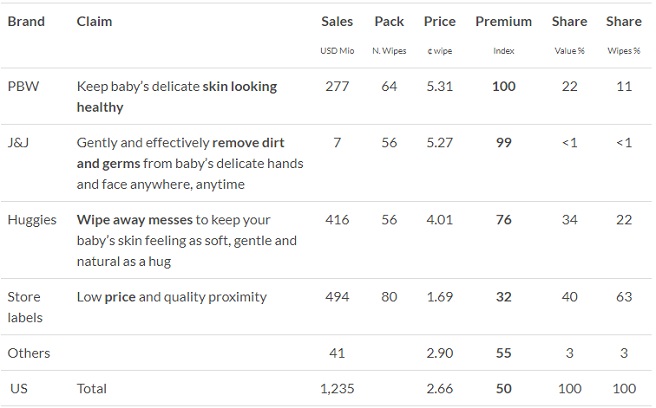
Table 1: Baby Wipes brand claim, price, and share. USA, 2016.
This table suggests two things:
- Strong strategic claims can deliver higher profit and significant share levels
- Weak strategic claims command lower prices or your brand won’t stay around for long
Brand claims move from Health to Convenience on the horizontal axis of Map 1.
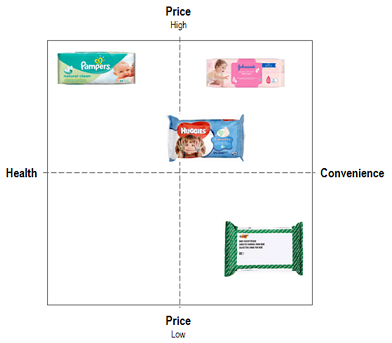
Map 1: Baby Wipes competition map.
Johnson’s effectiveness in removing dirt and germs and Huggies’ ability to wipe away mess make them task convenient brands. These are messages centered on the mom and her job. They are egoist claims. Pampers instead calibrated the message on the baby and its healthy skin. This is an altruistic, caring and loving message.
Based on straight common sense, which claim would you choose to communicate about the needs of helpless, tender, sweet babies? I can’t vote for task efficiency. Babies call for health, care and love, and not for “jobs quickly done”. Pampers were smart enough to fill this space, leaving Johnson and Huggies no other choice than positioning on convenience. But convenience has a cost in this market, and Johnson learned it the hard way: they capitulated. Huggies did a better job, yet they had to give up a quarter of Pampers price in order to stay abreast.
This means Pampers is way more profitable, which allows them to research and bring new and improved products to the market, and customer appreciation is shown by the fact that 22% of the money spent on baby wipes goes to Pampers. Pampers is more profitable because it speaks to persons, who are ready to pay a premium in order to have the necessary quality for the loving care of their babies.
The bottom line: when positioning brands, consider what market segment may generate your profit. Otherwise, you are destined to follow rather than lead through innovation, and ultimately have to either cut profits or leave the market.
Keep reading. This article is about communication claims that deliver what they promise.
The Copy Strategy
The Copy Strategy determines what to tell customers about your brand, so to win their preference.
It is the execution of the Positioning Statement. It sets a measurable objective and it is built upon three elements:
- Benefit or promise the brand makes to customers (f.i. [Brand X] washes clothes cleaner and whiter than any other detergent)
- Support or reason why customers should believe the promise the brand makes (often linked to R&D and product formulation)
- Tone or how the brand should be perceived (f.i. Modern and progressive)
These elements are chosen before creating the Positioning Statement and as usual you must support each choice with evidence from surveys and other reliable sources.
An example of Copy Objective:
The objective of [BRAND X] copy is to convince {MARKET} users that its cleaning performance is superior to that of major competing brands.
Read also: How to judge an advertisement
A real advertising strategy, aka copy strategy
Pampers is the leading baby diaper brand. In their Baby Discovery Center near Cincinnati every year they run hundreds of tests to find out what is meaningful to parents and babies about diapers. This led to the introduction of Pampers Baby Wipes (PBW), wet tissues used to cleanse babies (primarily when changing diapers). At launch time in 1994, the copy strategy of PBW read:

Table 2: Advertising Strategy of Pampers Baby Wipes.
Disarmingly simple, isn’t it? Common sense and surveys inspired this advertising strategy while massive investments have established the brand.
Try LogRatio’s fully automated solution for the professional analysis of survey data.
In just a few clicks LogRatio transforms raw survey data into all the survey tables and charts you need,
including a verbal interpretation of the survey results.
It is worth giving LogRatio a try!
The product first
First create the product for the job. A copy strategy can only deliver as much as the product does.
Moms answered marketing research studies on their expectations about baby wipes. In order of importance, they said baby wipes should be:
-
- Friendly to the baby’s skin
- Smooth and tender
- With cleaning power
- Easy to use
- Reasonably priced
So P&G went to the lab and learned how to make wet wipes according to the expectations of moms and the needs of babies from newborn to 36 months old. Wipes are either a paper product or a synthetic fabric. Image 3 shows (toilet) paper isn’t quite smooth and tender when observed under the microscope, and neither is it friendly to skin.

Image 1: Microscopic image of (l.) toilet paper and (r.) paper with a smoother texture.</span></p>
Modifying paper texture fixed the “smooth and tender” issue. When moms said the solution was ok (with product tests in comparison to direct competitors) and the product could be profitable enough they launched on heavy advertising and promotional activities.
How to execute the copy strategy
Watch the following commercials from 1995 and 2014 respectively. They say a lot about how to execute the advertising strategy.
Video 1: Pampers Baby Wipes. UK, TV advert 1995.
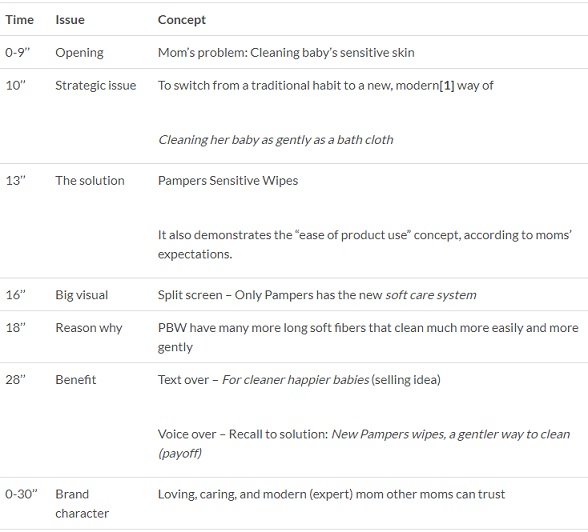
Table 3: Summary script of Pampers Baby Wipes. UK, TV advert from 1995.
This video’s script, although 20+ years old, follows a pattern still in use today. It makes moms aware of the new product while giving them a reason to change their habits[2]. It opens with the problem; it suggests a solution and gives a reason to believe it. And it does so in a calm, warm, and conscious way moms can trust (character).
Although brands evolve and new competitors enter the playing field, the copy strategy stays coherent over time with its original meaning. This doesn’t mean you can’t extend the benefit. Just don’t compromise the brand.
Now watch this 2014 PBW commercial from the USA.
Video 2: Pampers Baby Wipes. US, TV advert 2014.
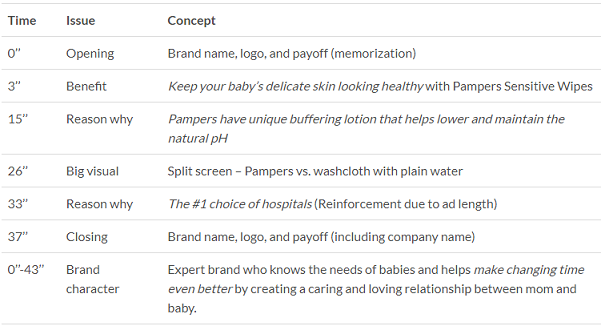
Table 4: Summary script of Pampers Baby Wipes. US, TV advert from 2014.
The product was improved (buffering lotion), the reason why was reinforced (hospitals’ choice), and the benefit extended (skin looking healthy), but without compromising the original “gentle cleaning” concept, which in fact is contained in the “healthy skin” concept.
The brand remained loyal to its heritage, and it executed the same strategic concept throughout all communication channels and media.
Ad opening and brand name
Interestingly, these TV spots have two completely different openings. The 2014 ad begins with the brand name while the 1995 one opens on mom and baby and the brand name appears only at second 11-13.
You might have heard that the brand should be mentioned within the first 6 seconds of TV commercials. The reason to mention the brand early is to build awareness quickly. This rule permits an exception, however, when the ad captures the attention, for instance with a new solution to an old problem. This is the case of the 1995 ad which in fact suggests a modern and improved way of cleaning babies as opposed to the traditional washcloth.
Humor is another way to keep the audience watching. Watch how Febreze did it with DavesBleepDontStink. Humor, however, is a tricky one. It works only when linked to the product technical performance, otherwise it may choke the brand and waste resources.
Longitudinal analysis of the advertising strategy execution
The copy strategy doesn’t change over time. What does change is the execution of the strategy.
Pampers Baby Wipes have always offered gentle cleaning. Over time, however, despite the many commercial variations, the Copy strategy hasn’t substantially changed from the original version of “Pampers Baby Wipes clean easily and gently”. They:
- Reinforced the concept of gentleness (to maintain product superiority)
- 1995 Modified the wipe texture to make it gentle and strong
- 2008 Added a bath fresh lotion
- 2014 improved ph balancing lotion
- Spoke to different customers (to extend the user base and reach the market leadership objective)
- 2002 Moms wishing all natural cleaning (no scent and alcohol), with Natural Clean Wipes
- 2008 Moms of babies (6-12 months) and toddlers (12+ months), with the Baby Fresh Wipes
- 2016 Moms of newborns (0-6 months), with the Sensitive Wipes
- Suggested product use in different situations (to broaden the source of business)
- 2004 Bath time
- 2005 Mess time
- 2007 All dirt at any stage
Closing
Creating a copy strategy that delivers what it promises is a long process built on coherence. The key steps are:
-
- Define a realistic role your brand may play on the market (leader, challenger, follower, or niche player)
- Select the people to speak to
- Make the product your audience wants
- Make it profitable
- Seize the strongest claim
- Execute the copy strategy consistently over time
Read also how to judge a copy strategy according to the principles of strategic marketing.
______________________________
[1] The modern way is symbolized with a few frames around second 8. The kitchen is modern and neat, not cheap; it is presumably a family-house, not a condo, in a pleasant neighborhood; she looks happy and dynamic; both mom and baby are well groomed and dressed in a fashionable, fresh manner. This is an image many moms may like to be associated with, and this is the kind of positive reaction the management aims for, in an attempt to add value to the brand.
[2] From the traditional washcloth and water to a new, modern alternative to clean babies.

